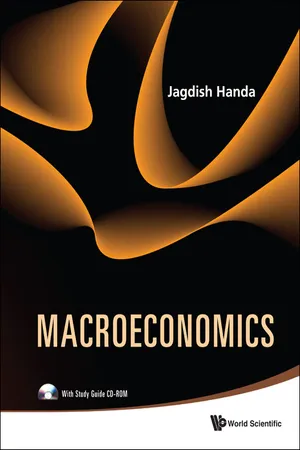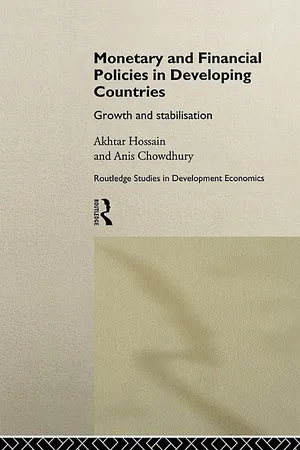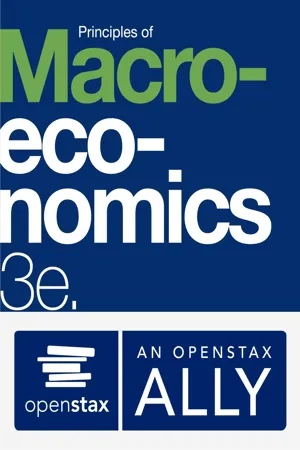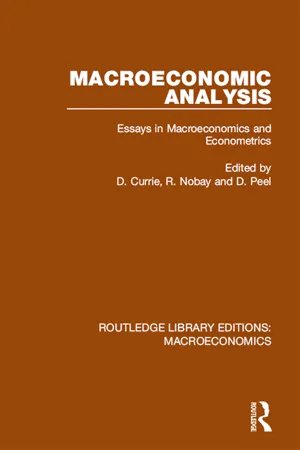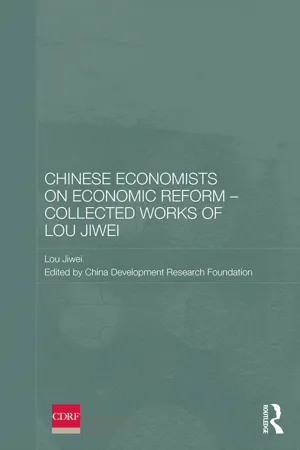Economics
Aggregate Money Demand
Aggregate money demand refers to the total amount of money that individuals and businesses in an economy want to hold for transactions and speculative purposes. It is influenced by factors such as income levels, interest rates, and price levels. Understanding aggregate money demand is important for policymakers in managing monetary policy and ensuring price stability.
Written by Perlego with AI-assistance
Related key terms
1 of 5
11 Key excerpts on "Aggregate Money Demand"
- eBook - ePub
Macroeconomics
(With Study Guide CD-ROM)
- Jagdish Handa(Author)
- 2010(Publication Date)
- WSPC(Publisher)
m = M/ P .Money balances are held by households and firms for several reasons, the most important of which are:• Households hold money balances to facilitate their purchases of commodities; firms hold money balances to facilitate production of commodities and employment of inputs. Such balances depend on the cost of holding money. Since money holdings do not pay interest, the cost of holding them is the return foregone by not holding interest-paying bonds. The demand for money under this category is called the transactions demand for money. This transactions demand is a function of national income and the interest rate. It increases if income increases and decreases if the interest rate rises.• Investors (including both households and firms) hold money balances for some time while switching among investments. This component of money demand is combined with the following speculative component of money demand.• Both households and firms hold money balances to diversify their portfolios, so as to reduce their exposure to risk. For example, in riskier environments, when stock markets are volatile, investors increase the proportion of their portfolio held in money, as well as of other highly liquid financial assets.3 The money balances held for this reason depend on the return on investments and their perceived riskiness, as well as the size of the portfolio (i.e., amount of wealth). The return on investments is approximated by the interest rate on bonds, so that money demand depends on interest rates and wealth. This component of money demand is often called the speculative demand for money. - eBook - PDF
Macroeconomics
A Contemporary Introduction
- William A. McEachern(Author)
- 2016(Publication Date)
- Cengage Learning EMEA(Publisher)
Along a given money demand curve, the quantity of money demanded relates in- versely to the market interest rate, other things held constant. The demand for money curve shifts rightward as a result of an increase in the price level, an increase in real GDP, or an increase in both. 2. The Fed determines the supply of money, which is assumed to be independent of the interest rate. The intersection of the supply and demand curves for money determines the market interest rate. In the short run, an increase in the supply of money reduces the interest rate, which increases investment. This boosts aggregate demand, which increases real output and the price level. 3. The long-run approach focuses on the role of money through the equation of exchange, which states that the quantity of money, M, multiplied by velocity, V, the average number of times each dollar gets spent on final goods and services, equals the price level, P, multiplied by real output, Y. So M 3 V 5 P 3 Y. Because the aggregate supply curve in the long run is a vertical line at the economy’s potential output, a change in the money supply affects the price level but not real output. 4. Between World War II and October 1979, the Fed tried to maintain stable interest rates as a way of promoting a stable investment environment. During the 1980s and early 1990s, the Fed paid more attention to growth in money aggregates, first M1 and then M2. But the velocity of M1 and M2 became so unstable that the Fed shifted focus back to interest rates, particularly the federal funds rate. To pursue its mandated goals of price stability and maximum employment, the Fed uses open-market operations to adjust the federal funds rate, raising the rate to prevent higher inflation and lowering the rate to stimulate employment. - eBook - PDF
Macroeconomics for Business
The Manager's Way of Understanding the Global Economy
- Lawrence S. Davidson, Andreas Hauskrecht, Jürgen von Hagen(Authors)
- 2020(Publication Date)
- Cambridge University Press(Publisher)
The more interesting questions and more controversial debate centered on what would happen after the economy recovered from the recession. Supply-side economists worried that the Fed might stimulate aggregate demand too much and for too long. In that case, inflation would become a real concern. Demand-side economists, in contrast, worried that the Fed did not exert enough stimulus and that unemployment would remain too high and employment too low for too long. Macro Concepts and Analysis 129 for the goods and services they purchase and to settle their debts, and firms use it to pay their workers, capital owners, and suppliers. In modern, developed economies, the government defines a specific asset as legal tender, i.e., as valid for meeting financial obligations. In the US, dollar bills and coins are legal tender, in the euro area, euro bills and coins, in the UK, sterling bills and coins. In practice, most payments are not made in legal tender, because people do not want to carry around large amounts of cash. Instead, they use close substitutes to cash, i.e., certain types of bank deposits. Since checks drawn on demand deposits are widely accepted as payments, it is plausible to include demand deposits issued by domestic banks in a definition of money. So is the inclusion of traveler’s checks and other checkable deposits at banks and depository institutions such as credit unions. This gives us a first (narrow) definition of money: Narrow money (M1) is the sum of currency circulating in the economy plus the stock of demand deposits at domestic banks and other checkable deposits at domestic depository institutions plus traveler’s checks issued by domestic banks held by non-banks in the economy. One criticism is that M1 may be too narrow to include everything used as money. You may have some very liquid financial assets that you could sell quickly to purchase something. - eBook - PDF
Economics
Principles & Policy
- William Baumol, Alan Blinder, John Solow, , William Baumol, Alan Blinder, John Solow(Authors)
- 2019(Publication Date)
- Cengage Learning EMEA(Publisher)
Although it is true that income determines consumption, the consumption function in turn helps to determine the level of income. If that sounds like circular reasoning, read the next chapter! Summary 1. Aggregate demand is the total volume of goods and ser- vices purchased by consumers, businesses, government units, and foreigners. It can be expressed as the sum C + I + G + (X – IM), where C is consumer spending, I is investment spending, G is government purchases, and X – IM is net exports. 2. Aggregate demand is a schedule: The aggregate quantity demanded depends on (among other things) the price level. But, for any given price level, aggregate demand is a number. 3. Economists reserve the term investment spending to refer to purchases of newly produced factories, machin- ery, software, and houses. 4. Gross domestic product is the total volume of final goods and services produced in the country. 5. National income is the sum of the before-tax wages, interest, rents, and profits earned by all individuals in the economy. By necessity, it must be approximately equal to domestic product. 6. Disposable income is the sum of the incomes of all indi- viduals in the economy after taxes and transfers. It is the chief determinant of consumer expenditures. 7. All of these concepts, and others, can be depicted in a circular flow diagram that shows expenditures on all four sources flowing into business firms and national income flowing out. 8. The close relationship between consumer spending (C) and disposable income (DI) is called the consumption function. Its slope, which is used to predict the change in consumption that will be caused by a change in income taxes, is called the marginal propensity to consume (MPC). 9. Changes in disposable income move us along a given consumption function. Changes in any of the other vari- ables that affect C shift the entire consumption function. - eBook - ePub
- Krish Bhaskar, David F. Murray(Authors)
- 2015(Publication Date)
- Routledge(Publisher)
Figure 11.10 . At this new equilibrium the individual will, in general, hold a different portfolio of money and bonds and we again derive an interest elastic demand for money function, although whether the relationship is inverse or proportional again depends on the relative strengths of the substitution and income effects. Changes in the individual’s expectations concerning the rate of inflation may also affect the efficiency locus and hence the demand for speculative cash balances so that the proportion of an individual’s wealth held in real cash balances is determined by the current rate of interest on bonds, expectations concerning the rate of inflation and expectations about the future price of bonds (assumed not to change). Going from the individual’s demand function to the aggregate demand function as we did in the absence of inflation the following aggregate speculative demand for nominal cash balances is derived.11.49M s d=P W f ( R, π )The total demand for money
The conclusion to both Friedman’s restatement of the quantity theory and the neo-Keynesian approach to the demand for money is that the total demand for money can be expressed by the general function below.11.50=M dPg ( W, R, Y, π )We should notice that to derive this formulation from Friedman’s restatement of the quantity theory we must replace the return on bonds and the return on equities by a single rate of interest, assume that tastes and the ratio of human to non-human capital are unchanged, and replace permanent income by wealth and current income. It is this latter point which is perhaps the major difference between neo-Keynesian and neo-classical views of the demand for money function.The empirical evidence
We shall simply attempt to summarise the more important empirical work here. More detailed accounts are given in the selected readings at the end of the chapter. The first attempts to estimate the demand for money function employed a standard Keynesian schedule (without money illusion in the speculative demand) such as that shown in equation 11.51.11.51where ℓ(R) was often reduced to b/R.=M dPmY + l ( R )The drawback with this was that the transactions demand function derived earlier suggests that the demand for money is not directly proportional to the level of real income and not inversely related to the interest rate. Most recent work has, therefore, postulated a demand function such as equation 11.52. - eBook - PDF
- William Boyes, Michael Melvin(Authors)
- 2015(Publication Date)
- Cengage Learning EMEA(Publisher)
Aggregate expenditures are the sum of consumption, investment, government spending, and net exports. 2. Consumption depends on household income, wealth, expectations, demographics, and taxation. 3. Investment depends on the interest rate, technology, the cost of capital goods, and capacity utilization. 4. Government spending is determined independent of current income. 5. Net exports depend on foreign and domestic incomes, prices, government policies, and exchange rates. Chapter 8 Macroeconomic Equilibrium: Aggregate Demand and Supply 151 Copyright 2016 Cengage Learning. All Rights Reserved. May not be copied, scanned, or duplicated, in whole or in part. Due to electronic rights, some third party content may be suppressed from the eBook and/or eChapter(s). Editorial review has deemed that any suppressed content does not materially affect the overall learning experience. Cengage Learning reserves the right to remove additional content at any time if subsequent rights restrictions require it. the demand curve to slope down. Instead, the aggregate quantity demanded, or total spend-ing, will change as the price level changes as a result of the wealth effect, the interest rate effect, and the international trade effect of a price-level change on aggregate expenditures. We will discuss each of these effects in turn. 8-3a-1 The Wealth Effect Individuals and businesses own money, stocks, bonds, and other financial assets. The purchasing power of these assets is the quantity of goods and services for which the assets can be exchanged. When the level of prices falls, the purchasing power of these assets increases, allowing households and businesses to purchase more. When prices go up, the purchasing power of financial assets falls, causing households and busi-nesses to spend less. This is the wealth effect (sometimes called the real-balance effect ) of a price change: a change in the real value of wealth that causes spending to change when the level of prices changes. - eBook - ePub
Monetary and Financial Policies in Developing Countries
Growth and Stabilization
- Anis Chowdhury, Akhtar Hossain(Authors)
- 2003(Publication Date)
- Routledge(Publisher)
The idea that an excess real money supply affects real expenditure is a major feature of the monetary approach to inflation and the balance of payments theory (Paris, 1961; Swoboda, 1976; Aghevli and Sassanpour, 1982; Hossain 1989). In this theory, the adjustment process to monetary disequilibrium implicitly assumes an aggregate private expenditure function which depends not only on the level of real disposable income but also on a variable which measures the extent of disequilibrium in the real money market. Economic agents are assumed to spend more or less than their real disposable income depending on whether they are running down or accumulating money balances. Therefore, an excess money supply positively affects the level of private expenditure, and excess demand for money balances results in a reduced level of private expenditure.In sum, a well-defined and stable demand for money function is a necessary condition for discretionary changes in the money supply to have predictable effects on ultimate target variables, such as inflation, output, employment and the balance of payments (Aghevli et al., - eBook - PDF
- David Shapiro, Daniel MacDonald, Steven A. Greenlaw(Authors)
- 2022(Publication Date)
- Openstax(Publisher)
In this example, the vertical line in the exhibit shows that potential GDP occurs at a total output of 9,500. When an economy is operating at its potential GDP, machines and factories are running at capacity, and the unemployment rate is relatively low—at the natural rate of unemployment. For this reason, potential GDP is sometimes also called full-employment GDP. The Aggregate Demand Curve Aggregate demand (AD) refers to the amount of total spending on domestic goods and services in an economy. (Strictly speaking, AD is what economists call total planned expenditure. We will further explain this distinction in the appendix The Expenditure-Output Model . For now, just think of aggregate demand as total spending.) It includes all four components of demand: consumption, investment, government spending, and net exports (exports minus imports). This demand is determined by a number of factors, but one of them is the price level—recall though, that the price level is an index number such as the GDP deflator that measures the average price of the things we buy. The aggregate demand (AD) curve shows the total spending on domestic goods and services at each price level. Figure 11.4 presents an aggregate demand (AD) curve. Just like the aggregate supply curve, the horizontal axis shows real GDP and the vertical axis shows the price level. The AD curve slopes down, which means that increases in the price level of outputs lead to a lower quantity of total spending. The reasons behind this shape are related to how changes in the price level affect the different components of aggregate demand. The following components comprise aggregate demand: consumption spending (C), investment spending (I), government spending (G), and spending on exports (X) minus imports (M): C + I + G + X – M. CLEAR IT UP 276 11 • The Aggregate Demand/Aggregate Supply Model Access for free at openstax.org - eBook - ePub
- Kenneth K. Kurihara(Author)
- 2013(Publication Date)
- Routledge(Publisher)
i.e., if the amount of money demanded for speculative purposes were proportionate to the amount of money and the price level—then it would no longer be true that the only way this demand could absorb part of the increase in the amount of money would be through a fall in the rate of interest. For, even at the same rate of interest, the rise in prices and amount of money would cause the amount of speculative demand to increase. Hence the rate of interest need not change.This completes our description of the four specific assumptions which must be made in order to insure the validity of the quantity theory. It is equally instructive to discuss some assumptions which need not be made for this purpose:(1) Aside from the absence of money illusion, there is no need to place any further restriction on the form of the aggregate demand function, or any other function.Our main interest at this point is in the aggregate demand function. In the preceding analysis this has been assumed to have a rather general form. In particular, there was no need to assume that an increase in the amount of money causes a proportionate increase in the aggregate amount demanded.At the same time it should be noted that aggregate monetary expenditures in the new equilibrium period (what Keynes called “the effective demand”30 ) have increased over those of the initial period in the same proportion as has the amount of money. For by denoting the real aggregate expenditure in the initial equilibrium position by E0 (see Figure 1 above), aggregate money expenditures in this period can be represented by p0 E0 . Now assume that the amount of money in circulation increases from M0 to (1 + t)M0 . The preceding analysis has shown that aggregate money expenditures in the new equilibrium position increase proportionately to (1 + t)p0 E0 .Superficially, there seems to be a paradox here. But the following simple explanation immediately resolves it. In brief, the two preceding statements actually correspond to two completely different conceptual experiments. In the first we take a given group of consumers with given real incomes and nominal money balances, and confront them with a given rate of interest and price level. For this given situation we ask them how much (in real terms), they would like to buy. We then increase the nominal amount of their money balances, holding all other variables constant - eBook - ePub
Macroeconomic Analysis
Essays in macroeconomics and econometrics
- David Currie, R Nobay, David Peel(Authors)
- 2015(Publication Date)
- Routledge(Publisher)
Governments which wish to control the money supply have very specific definitions of M 1 such as currency plus demand deposits, and they must consider such issues as whether vault cash is considered part of M 1 or not. For the level of generality of the discussion in this paper I shall define M 1 to be noninterest bearing forms of assets which are normally used for transactions purposes. The question arises: what determines how much money people hold? or, in the economist’s jargon, what is the demand for money? There has never been any doubt that the demand for money depends on nominal income, although prior to the use of aggregate income as a common concept, this thought was expressed in slightly different ways. If the demand for money depends only on nominal income but on no other variable, and if demand equals supply, a central bank capable of controlling the money supply will also be capable of controlling nominal income; and furthermore, in this regard, no other policy matters. To the Keynesians, who felt that nominal income depended not only on the money supply, but potentially also on other factors such as government expenditure and taxes, it was a prime necessity to explain why some variable other than nominal income might affect money demand. The Keynesian choice for the second variable was the nominal rate of interest. This is indeed a natural choice since money, as I have defined it, is M 1 ; anyone who holds M 1 is giving up interest returns on alternative assets, or perhaps borrowing at the rate of interest in order to hold more money. So the rate of interest reflects the opportunity cost of holding money and, as such, can be considered the “price” of money holding; and, as any economist knows, the demand for almost any good is most naturally written as a function of income and its own price (with the prices of other goods perhaps also added). The Keynesians have given three specific justifications why the demand for money depends on the rate of interest - Lou Jiwei, China Development Research Foundation(Authors)
- 2013(Publication Date)
- Routledge(Publisher)
Some people hold that control over aggregate demand is unimportant in an economy whose market is still rudimentary. They give three reasons for this. First, the total size of the economy and the economy’s annual growth rate are a function of the will of the leaders of the country, and hence are not related to aggregate demand. Second, because of relatively extensive direct interventions in pricing, even if aggregate demand is excessive, prices should not rise. If they do rise, it is because of intentional ‘price adjustments.’ Third, since market signals are relatively insensitive and the liquidity of factors of production is low, trying to control aggregate demand and trying to make adjustments to the economic structure are so intermeshed that control is too difficult. I believe that this is an incorrect understanding of the situation and that the conclusion is therefore superficial. First, no matter how fast the leaders want to grow production, unless they expand lending and public spending and thus expand the money supply, they won’t be successful. In the end, high-speed growth will only be achieved by increasing aggregate demand. Second, excess demand can turn into pressure for price increases or hidden inflation even if it does not immediately take the form of inflation, and sooner or later inflation will break out, forcing direct control of prices by our governmental agencies. Third, saying that controlling aggregate demand and adjusting our economic structure are intermeshed merely affirms that control is difficult. It does not lower the need for policy coordination or diminish its importance.In short, ‘maintaining aggregate demand and aggregate supply equilibrium’ is a basic economic principle that does not change depending on the type of economic system, nor does it become any less important. It involves a decision-making process that includes a number of policy considerations, including accurate understanding of national economic strength, a scientific forecast of aggregate supply, formulating coordinated policies on supply and demand management (especially important for an economy whose market is in early stages), and assuring that aggregate demand should be in conformity with aggregate supply. It contains the policy implication that the government should make proactive policy interventions in the economy in order to enable national strength, pursue people’s well-being, and ensure economic stability.The sum of ‘national income use’ refers to the net national product that is distributed at current prices, including net imports and the net foreign capital inflow. Therefore, when the sum of national income use outpaces national income production, which means excessive distribution, the amount of the excess can be explained by the national income price deflator, net imports, and net foreign capital inflows. If the core substance of our aggregate policies is to maintain a balance in national income use and national income production, policy goals will be quite mixed up. First, equilibrium is fully able to appear at a level that is below aggregate supply. This is then expressed in the policy concept of ‘use whatever is produced,’ instead of a policy goal of producing as much as possible, and trying to arrange the corresponding level of ‘use’ so that production can reach the full potential of national strength. Second, this kind of thinking means pursuing an annual balance in balance of payments and the foreign capital inflows, which is detrimental to the dynamic adjustment of our policies every year in accordance with changes in the domestic and international economic situation. Third, the ‘scale of investment’ and the ‘scale of consumption’ are the control variables of aggregate scale and are directly related to money supply. But the ‘sum of national income use’ is not a variable like money supply, which can be dynamically adjusted in advance. Instead, it is an ex post facto statistical quantity, which has no direct links with the control variables.
Index pages curate the most relevant extracts from our library of academic textbooks. They’ve been created using an in-house natural language model (NLM), each adding context and meaning to key research topics.
